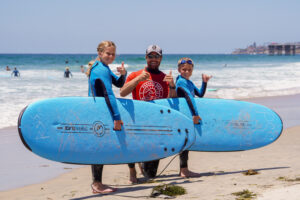Surfing has heaps of challenges. How you balance yourself on the board, interpreting waves, navigating your way in and out of the water, working with other surfers — these things can be pretty physically demanding!
But, a whole lot of first-timers are pleasantly surprised when they realize the most difficult part isn’t when you are surfing a wave. To their surprise, paddling is yet the hardest part — for beginners.
More than seventy-five percent of your energy spent on the water will be mostly about paddling and positioning. That said, most of surfing is spent getting to where you want to be and then staying there.
Looking at the waves, positioning, and working up the timing is truly hard work. It becomes even more challenging if paddling has started to drain your energy. The feat is almost effortless to the advanced surfer, but for people who have never quite used those muscles this way in surfing, paddling can be exhausting.
So, how do you improve your paddle strength?
TECHNIQUE
Positioning: on the board, make certain you’re in the correct spot. Your weight can be a little bit forward. A position that’s too far forward causes drag in the nose; too far back and your whole board won’t be gliding on the water. Maintaining your weight positioned just right will allow you to glide seamlessly.
Form: head up, your gaze to where you’re going (not resting on the board). Shoulders are lifted, using your core to angle your back. Weight resting on your sternum and not to your chest. Ensure that your entire body is properly lined up on the stringer without leaning or rolling to one side or the other. Lastly, keep your feet together and out of the water. This helps avoid dragging your foot breaks while trying to speed up.
Hands: your hands will serve as blades — with fingers, little spaced from each other or together, keep them firm as you dig through the water. Think of them as the blade of a canoe paddle.
Follow-through: just continue stroking all the way through and past your body. Pulling your hand out early lessens how far your strokes will enforce you, and you can even create drag. Brief and quick strokes will get you nowhere! Deep and long strokes is the way to go, just dig through. Try to use every inch of your paddle, even using your fingers to sweep the water back.
STRETCH
Make sure you are flexible before hitting the water. Stretching is advised before proceeding to any activity as it helps you prevent soreness, maximizes performance, and helps you to avoid injury.
Dynamic stretches are more beneficial than static stretches. Also, keep yourself hydrated. Having ample water in the body affords your muscles to eliminate lactic acid more efficiently so be sure you’re drinking plenty of water.
Being flexible also means you should be comfortable enough to rotate your shoulders, the core and the balance of body weight to keep your shoulders up.
PRACTICE
To increase your strength during paddling, practice makes perfect. Even when the waves aren’t cooperative, it still is beneficial to just hop in the water and practice your paddling skills.
Try moving around on different sized boards, bearing in mind the difference in glide and stability funboards, shortboards, and longboards.
If you don’t live near the ocean, try paddling in pools or lakes. Some helpful tip for pool paddling: secure your board to the side of the pool so that it stays. Practice with high-intensity increments, all while staying still.
Come learn surfing with us and learn the correct paddling and surfing techniques. Pacific Surf School is prepared to give you a real surfing experience with our certified instructors.
Call us on (858)488-2685 or Book a Lesson by clicking here
Photo by Piotr Chrobot on Unsplash




